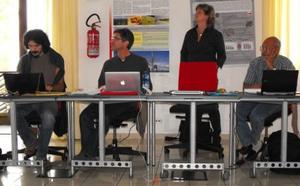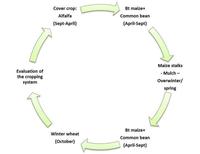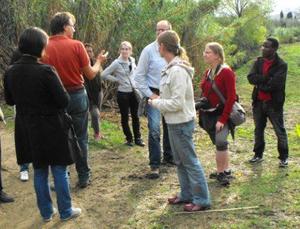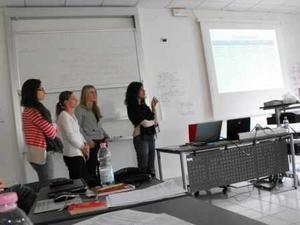See also
ENDURE Summer School 2012
Exploring the extent to which agroecology could be used for crop protection on European farms was the task set for the fourth ENDURE Summer School, which brought together 12 PhD students and five expert teachers for a five-day course in Italy.
The focus was on the application of agroecological principles to cropping systems and how the management of weeds, pests and diseases can be jointly addressed to exploit synergies and avoid negative interactions among management practices. The idea underlying this approach is that successful Integrated Pest Management (IPM) should not merely be based on ‘substitution’, in other words simply replacing chemical pest control with single mechanical or biological tactics.
In this report:
- Lecturer presentations
- Cropping system 1: Genetically modified (GM) maize in IPM: Intercropped maize-common beans
- Cropping system 2: An organic farm in Italy
- Cropping system 3: An agroecological approach to organic conversion
Historically, the organisers noted, there has been a wealth of work at the level of agroecological principles and the observation of agroecosystemic processes at work in family farms in the developing world. In contrast, the applicability of agroecology in average European-style farms is still in its infancy and the course sought to explore the extent to which agroecology can be exploited in this context.
This was achieved through a programme alternating classical lectures with teamwork and exercises in which students were stimulated to apply knowledge in an interdisciplinary way.
The lectures provided an overview of agroecology and IPM as well as more focused agroecological avenues relative to the management of plant diseases, weed communities, and insect pests. Marco Barzman (INRA) and Alain Ratnadass (CIRAD) covered the North and South American origins of agroecology, how it has been introduced to Europe, and the numerous forms it has taken - ranging from a social movement to a scientific discipline - and the relationship between IPM and agroecology.
Stefan Kühne (JKI) provided some clues for the management of insect pests drawing on plant protection in organic farming, the special case of predatory flies used in greenhouses, and also reported on a long-term work on hedges and field margins to increase biodiversity. Alain Ratnadass provided detailed reports of tropical experiences with direct-seeding mulch-based conservation agriculture against striga and white grubs in rice, push-pull strategies against insect pests in Niger, and agroforestry against the plant bug and brown pod rot in cocoa in Cameroon, and against the coffee berry borer and orange rust in coffee in Costa Rica.
Paolo Barberi (SSSA) explained how Integrated Weed Management based on diversifying cropping systems and weed control strategies offered agroecological solutions to control weeds in both conventional and organic systems and pointed to a better understanding of how multi-trophic interactions affect weed communities as the next research frontier in this area. Sabine Ravnskov (AU) explored the range of tactics available and our growing understanding of the importance of mycorrhizae for non-chemical disease control.
The pdf files of these presentations are available below.
| Author(s) | Title | Download pdf |
| Marco Barzman (INRA, France) and Alain Ratnadass (CIRAD, France) | Overview of IPM |
Barzman & Ratnadass_Overview of IPM [pdf - 1,49 MB]
|
| Marco Barzman (INRA, France) and Alain Ratnadass (CIRAD, France) | Introduction to agroecology |
Barzman & Ratnadass_Introduction to agroecology [pdf - 2,17 MB]
|
| Paolo Barberi (SSSA, Italy) | Agroecology for IPM (1): Weed management |
Barberi_Agroecology for IPM - Weed management [pdf - 1,59 MB]
|
| Stefan Kühne (JKI, Germany) | Agroecology for IPM (2): Insect pests |
Kuhne_Agroecology for IPM - Insect pests [pdf - 2,18 MB]
|
| Sabine Ravnskov (AU) | Agroecology for IPM (3): Diseases |
Ravnskov_Agroecology for IPM - Diseases [pdf - 6,10 MB]
|
Team work comprised three parts: field work on insect monitoring and landscape observation, and the design of virtual cropping systems using agroecological principles for IPM.
For the latter task, three teams were assembled to build imaginary systems taking into account agronomic and biophysical factors as well as a few social and economic questions beyond the farm. One team built the systems around genetically modified maize intercropped with common bean in Spain and with particular regard to the European corn borer, Ostrinia nubilalis . A second team designed a 20-hectare organic farm in northern Italy and in their SWOT analysis (strengths, weaknesses, opportunities and threats) compared it to a farm in Kenya. A third team took an agroecological approach to converting a cropping system typical of the Burgundy region of France (a succession of oilseed rape, barley and winter wheat) to an organic production system integrating livestock. You can read summaries of these case studies below:
Cropping system 1: Genetically modified (GM) maize in IPM: Intercropped maize-common beans
Authors: Emese Baloc (Gödöllö University (SZIE), Hungary), Noémie Chervet (Agroscope Changins-Wädenswil Research Station (Agroscope ACW), Switzerland), Gaëlle Marliac (Institut National de la Recherche Agronomique (INRA), France), Nevena Nol (Scuola Superiore Sant'anna (SSSA), Italy).
The billion dollar bug, the European corn borer (Ostrinia nubilalis ), is a serious problem in maize farming in the European Union, especially in Spain (Meissle et al ., 2010). Pest infestation can lead to harvest losses of up to 30 % (ENDURE Summer School 2010, ENDURE Maize Case Study Guide No.1). IPM is being requested from all EU farmers by 2014 (Framework Directive 2009/128/EU) and therefore alternative control methods should be explored in parallel to their agroecological fitness.
In our case study we would observe the agronomic and environmental effects of integrating Bt maize (Zea mays L.) in an intercropped system with common beans (Phaseolus vulgaris L) ( Gepts & Bliss, 1988). Focusing on host plant resistance, we are addressing one of the basic principles of an IPM strategy. Bt maize provides almost 100% protection against all generations of corn borer, but also 15 lepidopteran pest species (Hellmich et al ., 2008; Hellmich & Hellmich, 2012).
Cultivation of GM crops has been increasing worldwide since the first release of GM Bt maize in 1996 in the USA and had reached 134 million hectares by 2009 (James, 2010), while insect-resistant maize production had expanded to more than 35 million hectares (James, 2009). Bt maize (transformation event MON 810, only authorised variety), contains genes from strains of Bacillus thuringiensis bacterium species and expresses Cry1Ab protein, which is toxic to larvae of lepidoptera species such as European corn borer.
Our trial would be located in northern Spain. Experimental fields would be surrounded by apple trees (field margin) and used as a buffer zone. In three years of crop rotation, alfalfa would be sown as a preceding cover crop and used the following year as a green manure. The use of coated seeds for this cash crop is a preventive measure against fungi (such as Fusarium spp., Ustilago maydis, Puccinia sorghi ) and common alfalfa pests (such as weevils, wireworms, grubs, Psalidium sp., Tanymecus sp .). Winter wheat would be included after two years of continuous intercrops (maize and beans). Field management after maize harvesting would be based on reduced tillage, but sufficient for grinding of plant tissue residues and efficient incorporation into the surface layer of the soil (mulch effect).
Weed management in the following year would be based on the false seedbed technique for spring and summer-emerging weeds. Finally, after the second year of intercropping, ploughing would be used to prepare the wheat seedbed. Figure 1 shows our crop rotation over the three years.
SWOT analysis
Strengths
- High efficacy of control of key pests (below economic injury level)
- Economic benefits (e.g. high yield and quality)
- No/less direct control measures needed (e.g. insecticides)
- GM crops have broadened opportunities for other IPM tactics such as biological control
- No adverse effects on natural enemies (biological control)
- No negative landscape effects (e.g. ecological functions preserved)
- Human health (e.g. low toxicological risks)
- Social benefits/awareness
Weaknesses
- Common bean is a host plant for ECB (Bt maize trap plant)
- Gene flow (apple trees, buffer zones)
- Dependence on seed companies (monopolistic approach)
- How to integrate GM plants in sustainable agricultural systems including organic agriculture?
- How can new technologies in agriculture become trusted by the public (not only GM plants)?
- Social sciences have to play a stronger role
- Limitations of the markets and marketing channels (consumers, requirements of the chain supermarkets etc.)
- Educational approach - through the media, publicity
Opportunities
- Intelligent resistance management could be a key for sustainable use of GM crops in IPM
- Pest resistant GM plants could be seen as an IPM component that can be optimised
- More research in this area related to the long-term effects
Threats
- Risk on non-target organisms - potential effect
- Development of resistance
- Public rejection of the trial (e.g. UK, GMO wheat)
- Additional security costs (geese, dogs)
- Political use and manipulation of GMO concept (both directions)
References:
Gepts, P., and F. A. Bliss, 1988: Dissemination pathways of common bean (Phaseolus vulgaris , Fabaceae) deduced from phaseolin electrophoretic variability. II. Europe and Africa. Econ. Bot. 42, 86—104.
Hellmich, R. L. & Hellmich, K. A. (2012) Use and Impact of Bt Maize. Nature Education Knowledge 3(10):4.
James, C. (2009): Global Status of Commercialized Biotech/GM Crops: 2008. ISAAA Brief No. 39. ISAAA: Ithaca, NY. 275 pp.
James, C. (2010): Global status of commercialized biotech/GM crops: 2009. ISAAA Briefs No. 41. ISAAA: Ithaca, NY.
Meissle, M., Mouron,P., Musa, T., Bigler, F., Pons, X., Vasileiadis, V.P., Otto, S., Antichi, D., Kiss, J., Palinkas, Z., Doner, Z., Van Der Weide, R., Groten, J., Czembor, E., Adamczyk, J., Thibord, J-B., Melander, B., Cordsen Nielsen, G., Poulsen, R. T., Zimmermann, O., Verschwele, A. And Oldenburg, E. (2010): Pests, pesticide use and alternative options in European maize production: Current status and future prospects. Journal of Applied Entomology , 134: 357-375.
Cropping system 2: An organic farm in Italy
Authors: Tim O’Donovan (Agriculture and Food Development Authority (TEAGASC), Ireland), Jovanka Saltzmann (Julius Kühn Institute (JKI), Germany), Ezekiel Mugendi (SSSA, Kenya) and Béatrice Rhino (Centre de coopération internationale en recherche agronomique pour le développement (CIRAD), France).
This exercise focuses on an organic farm located in northern Italy. The farming area is 20 hectares of good soil which has a four-year rotation: two years of good quality pasture with ryegrass and clover, and maize and barley grown for malting. The rotation has evolved to allow the farmer to complete the workload with limited labour input. Contractors are used for maize and barley drilling and harvesting. Cultivation and mechanical weed control are carried out by the farmer with his own machinery. A cover crop (see below) is cultivated between the maize and the spring cereal. Maize and malting barley are the main cash crops of the farm. Besides arable farming the farm has beef cattle for meat production. The animals are sold to local organic butchers who supply busy eco-tourist restaurants in the region.
Rotation
- Perennial ryegrass/clover ley
- Perennial ryegrass/clover ley
- Maize for grain/animal silage
- Barley for malting
In northern Italy, the western corn rootworm (WCR), Diabrotica virgifera virgifera LeConte (Coleoptera: Chrysomelidae) and the European corn borer (ECB), Ostrinia nubilalis (Lepidoptera: Pyralidae) are the most significant maize (Zea mays) pests. The rotation of maize with two years of pasture with ryegrass (Lolium multi?orum ) is a first step to having clean soil because ryegrass is not a host plant for WCR (Wilson and Hibbard, 2004). To control pests, organic farmers use biopesticides containing Bacillus thuringiensis but they are not sufficient. Farmers could use cultural controls such as flowers strips around or within maize fields in order to optimise biological control because flower strips provide nectar and pollen that are food for natural enemies and enhance the fitness of natural enemies (Zehnder et al., 2007; Rodriguez-Saona et al. 2012). Thus, flower strips could increase the populations of predators such as lacewings (Neuroptera: Chrysopidae), ladybirds (Coleoptera: Coccinellidae) and Anthocorid bugs. (Heteroptera, Anthocoridae) that attack lepidopteran eggs and larvae. For example, flowers strips with dill and coriander could increase the predation of O. nubilasis (Bickerton and Hamilton, 2012). Moreover, if the farmer were to use the parasitoid Trichogramma (Hymenoptera: Trichogrammatidae) to promote parasitism of WCR and ECB, the efficacy of this method should be increased by the presence of flowers because nectar enhances the survival of adult parasitoids, therefore their retention and the fecundity of female parasitoids. Another agroecological method of pest management is the spraying of entomophagous nematodes on corn leaves and soil to control WCR and ECB (Ben-Yakir, 1998; Kuhlmann and Burgt, 1998, Pilz et al., 2007).
Two years of pasture will, over time, reduce the weed seedbank on the farm as grass will not allow annual weeds to establish, especially in year two. It is critical that the pasture is very well established and high seed rates are employed as this will ‘smother’ any annual weeds germinating at the time of pasture establishment. This equally applies to perennial weed management as the weakest time in their lifecycle is when they are establishing.
A stale seedbed will be necessary to establish the maize as it is a crop that suffers up to 50% yield loss from weed competition especially in the first 50-80 days after drilling. The farmer should precision drill animal manure (from the cattle housing) close to the maize seed to help the crop grow rapidly during establishment. Mechanical weeding will also need to be carried out as required. After the maize is harvested, a cover crop (see below) will be established. For barley, this cover crop should reduce weed competition, carrying over from the maize and autumn-germinating weeds that might occur in the maize stubble. Mechanical weeding will also be needed in the barley crop, but as barley is ‘sink’ limited, the farmer needs to ensure the seeding rate is as high as possible (with respect to disease/lodging risks) and is established well to overcome weeds and therefore reducing yield losses.
A Vicia villosa Roth (Hairy vetch) cover crop is sown in October at the rate of 100 kg/ha-1 and incorporated into the soil in April the following year. The cover crop provides an effective ground cover, controlling surface run-off over the winter period. It controls most weeds and also provides a home for beneficial organisms, especially arbuscular mycorrhiza and nitrogen-fixing bacteria. After incorporation into the soil as a green manure, the cover crop readily releases nitrogen which enhances growth of the following crop, making it more competitive to any prevalent weeds and more resistant to pests and diseases.
SWOT analysis of the northern Italy farm compared to a farm in Kenya
Strengths
- Labour availability - cheap family labour is available in Kenya, expensive in Italy
- Cheaper cost of materials in Kenya
- More traditional knowledge, e.g. intercropping and pest control in Kenya
- Biodiversity with more heterogeneity in different scale e.g. more beneficial arthropods
Weaknesses
- Poor infrastructure, e.g. poorly developed road networks and markets
- Inaccessibility of inputs and farm machinery in Kenya
- More aggressive pests and diseases, e.g. the Osama maize storage weevil and striga weed in Kenya
- Unpredicted climate change and weather patterns and poor weather forecasts
- P fixation, aluminium toxicity and low soil pH
Opportunities
- Increased market due to rapid population growth and development, there is a likelihood of increased markets for commodities
- Space for more innovative cropping systems
- Cheaper access to some organic inputs, e.g. organic manure
- Expansion is possible, especially due to the availability of land at cheap prices
Threats
- New pests, weeds and diseases etc. may develop, e.g. maize lethal necrosis (maize chlorotic mottle virus and sugarcane mosaic virus) in Kenya
- Insecurity, political instability and natural catastrophes
- Lack of clear regulations and registration
References:
D. Ben-Yakir, D. Efron, M. ChenetI. Glazer.1998. Evaluation of entomopathogenic nematodes for biocontrol of the European corn borer,Ostrinia nubilalis, on sweet corn in Israel. Evaluation of entomopathogenic nematodes for biocontrol of the European corn borer, Ostrinia nubilalis, on sweetcorn in Israel.
Geoff Zehnder, Geoff M. Gurr, Stefan Kühne, Mark R. Wade, Steve D. Wratten, and Eric Wyss. 2007. Arthropod Pest Management in Organic Crops. Annual Review of Entomology, Vol. 52: 57 -80.
Kuhlmann, U., and W. A. C. M. Burgt. 1998. Possibilitiesfor biological control of the western corn rootworm, Diabrotica virgifera virgifera LeConte, in Central Europe. Biocont. News Inform. 19: 59 - 68.
M. W. Bickerton and G. C. Hamilton. 2012. Effects of Intercropping with Flowering Plants on Predation of Ostrinia nubilalis (Lepidoptera: Crambidae) Eggs by Generalist Predators in Bell Peppers. Environmental Entomology 41 (3), 612-620.
Pilz, C., Wegensteiner, R. and Keller, S. (2007), Selection of entomopathogenic fungi for the control of the western corn rootworm Diabrotica virgifera virgifera . Journal of Applied Entomology, 131: 426–431
Rodriguez-Saona Cesar, Brett R. Blaauw and Rufus Isaacs (2012). Manipulation of Natural Enemies in Agroecosystems: Habitat and Semiochemicals for Sustainable Insect Pest Control, Integrated Pest Management and Pest Control - Current and Future Tactics, Marcelo L. Larramendy and Sonia Soloneski (Ed).
Wilson Ted A. and Hibbard Bruce E. Host Suitability of Nonmaize Agroecosystem Grasses for the Western Corn Rootworm (Coleoptera: Chrysomelidae). Environmental Entomology 2004 33 (4), 1102-1108.
Cropping system 3: An agroecological approach to organic conversion
Authors: Nawel Aouadi (INRA, France), Rim Baccar (INRA, France), Orsolya Császár (SZIE, Hungary), Malaika Herbst (JKI, Germany)
Our team chose as the initial cropping system a succession of oilseed rape, barley and winter wheat, a commonly used cropping system in the Burgundy region of central France. This system is characterised by a clay-loamy soil and no irrigation is used. We propose to adopt an agroecological approach for converting this conventional system to organic production.
The first step consists of identifying weaknesses in the current crop rotation and proposing adequate solutions. First, we note that the system is characterised by a succession of only winter cereals and that the frequency of oilseed rape is high (every three years). This is likely to increase weed, disease and pest specialisation and to enhance the risk of disease persistence.
To avoid these problems, it is preferable to diversify sowing periods, to introduce other crop families such as leguminous plants, which also increase the soil’s nitrogen content, and to lengthen the crop succession. The following succession is thus proposed: oilseed rape-winter barley-pea-maize-clover-winter wheat. Some of these crops, such as wheat and oilseed rape, are commercial crops and others will be used for animal feed (for example, pea, clover, maize).
One of the major problems in organic farming is crop protection, as the use of synthetic chemicals is forbidden. To manage pests, we advise installing semi-natural habitats (for example, flower strips, hedgerows etc.) which provide shelter and food for beneficial organisms such as hoverflies, ladybirds and parasitoids that naturally destroy crop pests. It is also of major interest to spread mashed nettle, which is both a fertiliser and a plant strengthener.
The use of trap crops has proved to be very efficient against some oilseed pests. Thus planting early flowering oilseed plants or Brassica rapa plants among or around oilseed rape field helps reduce, for example, attacks from pollen beetles. Concerning maize pests, we can use Trichogramma sp. to control the European corn borer (Ostrinia nubilalis ), as well as Bacillus thuringiensis , an entomopathogenic nematode, to control western corn rootworm (Diabrotica virgifera virgifera ). It is also important to destroy crop volunteers to address other pests such as wheat nematodes and wheat wireworms (Agriotes sp .). Another biological control against take-all in cereals (Gaeumannomyces graminis ) consists of using Cerall, a biological product based on bacteria which avoids the build-up of mycotoxins in the soil.
The management of agronomic practices makes it possible to control crop diseases. It is therefore possible to reduce take-all attacks by reducing nitrogen fertilisation or to control septoria (Septoria tritici ) diseases by delaying the sowing date and reducing plant density. In addition, to protect wheat and barley against foliar diseases, the use of a mixture of resistant and sensitive cultivars can be of major benefit as resistant cultivars will act as barriers and therefore reduce disease severity.
Furthermore, we should not forget that the choice of crop succession is a very important factor in disease management. For this reason, we should avoid planting cereals on the same plot in two successive years and also avoid planting oilseed rape after maize to circumvent the development of sclerotinia (Scelrotinia sclerotiorum ).
Concerning weed management, we advise the use of preventive or direct measures depending on the crop, the type of weeds and the soil state. Preventive measures such as the creation of false seedbeds to enhance weed emergence before crop emergence, ploughing before seeding to bury weed seeds and the management of the date and density of sowing are techniques used before the establishment of the crop which aim to both decrease weed biomass and increase crop competitiveness. Conversely, direct measures such as mechanical weeding are used during crop development.
SWOT analysis
Although the type of soil and climate in this system offer good opportunities for high yields thanks to the good capacity for water storage, they can represent a high risk of compaction and soil erosion, and difficulties in soil tillage when there is high rainfall.
The diversification of crop succession, the introduction of livestock in the system and the absence of synthetic chemicals drastically increases biodiversity. However, we should pay attention to not increase nitrate volatility by excessive use of livestock manure.
Concerning organisational aspects, the location of the farm can present both advantages and drawbacks. For example, the existence of organic farming communities around the farm, which is the case in this region of France, will help initiate the farmer into this new sector, and the exchange of knowledge and the experiences of others will help the farmer promote his project. Also, the proximity of the farm to the cooperatives will facilitate the collection and transport of products such as wheat and milk. However, if the farm is too close to conventional farms this can be a threat. Indeed, chemicals (pesticides, fungicides, herbicides) used by the surrounding conventional farms can be dispersed by the wind and contaminate the organic farm.
Organic farms need a high number of qualified workers, which are not easily found. At the same time, this makes it possible to hire a higher number of workers and thus provide more employment in the region.
From an economic point of view, one of the difficulties of this kind of farming is the high investment cost and the risk of banks refusing to give loans because of the instability of farm yields, at least at the start of the project. However, these difficulties can be counterbalanced by the existence of government policies which encourage organic farming and offer help during the conversion period through, for example, subsidies. But this kind of help does not exclude the difficulty and length of the conversion process, which lasts at least two years and during which farm products are not considered organic and are therefore sold at low prices. But, once this procedure is completed and certification obtained, the products are recognised as organic and have a higher selling value.
Last update: 24/05/2023 - ENDURE © 2009 - Contact ENDURE - Disclaimer




